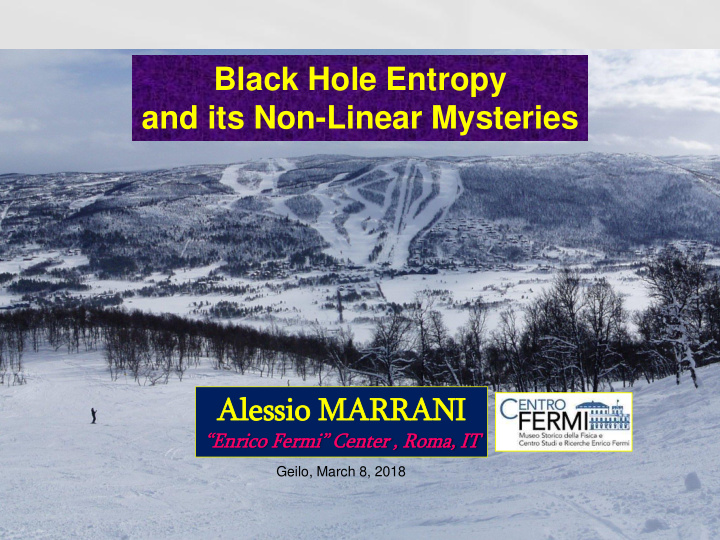



Black Hole Entropy and its Non-Linear Mysteries Ale lessio MARRANI “Enrico Fermi” Center , Roma, IT Geilo, March 8, 2018
Summary Maxwell-Einstein-Scalar Gravity Theories Symmetric Scalar Manifolds : Application to ( Super)Gravity and Extremal Black Holes Attractor Mechanism The matrix M and Freudenthal Duality Groups “of type E 7 ”
Maxwell-Einstein-Scalar Theories D=4 Maxwell-Einstein-scalar system (with no potential) [ may be the bosonic sector of D=4 (ungauged) sugra ] Abelian 2-form field strengths static, spherically symmetric, asymptotically flat, extremal BH dyonic vector of electric & magnetic fluxes ( BH charges )
reduction D=4 D=1 : effective 1-dimensional (radial) Lagrangian BH effective potential Ferrara, Gibbons, Kallosh eoms Attractor Mechanism : near the horizon, the scalar fields are stabilized purely in terms of charges Bekenstein-Hawking entropy-area formula for extremal dyonic BH
Symmetric Scalar Manifolds Let’s specialize, for a moment, the discussion to theories with scalar manifolds which are symmetric cosets G/H [ N>2 : general, N=2 : particular, N=1 : special cases ] H = isotropy group = linearly realized; scalar fields sit in an H -repr. In general : G = (global) electric-magnetic duality group [in string theory : U-duality ] G is an on-shell symmetry of the Lagrangian The 2-form field strengths (F,G) vector and the BH e.m. charges sit in a G -repr. R which is symplectic : symplectic product Gaillard-Zumino embedding (generally maximal, but not symmetric) Dynkin, Gaillard-Zumino
❖ symmetric vector mults ’ scalar mfds of N=2, D=4 sugra [PVS]
let ’s reconsider the starting Maxwell-Einstein-scalar Lagrangian density …and introduce the following real 2n x 2n matrix :
…by virtue of this matrix, one can introduce a (scalar-dependent) anti-involution in any Maxwell-Einstein-scalar gravity theory with symplectic structure , named ( scalar-dependent ) Freudenthal duality (F-duality) : Ferrara,AM,Yeranyan; Borsten,Duff, Ferrara,AM By recalling Freudenthal duality can be related to the effective BH potential :
All this enjoys a remarkable physical interpretation when evaluated at the horizon : Attractor Mechanism Bekenstein-Hawking entropy …by evaluating the matrix M at the horizon one can define the horizon Freudenthal duality as: non-linear (scalar-independent) anti-involutive map on Q (hom of degree one) Bek.-Haw. entropy is invariant under its non-linear symplectic gradient (defined by F-duality ) : This can be extended to include at least all quantum corrections Ferrara, AM, Yeranyan with homogeneity 2 or 0 in the BH charges Q (and late Raymond Stora)
Lie groups “ of type E 7 ” : (G, R ) Brown (1967); Garibaldi; Krutelevich; Borsten,Duff et al. Ferrara,Kallosh,AM; ❖ the (ir)repr. R is symplectic : AM,Orazi,Riccioni symplectic product ❖ the (ir)repr. admits a unique completely symmetric invariant rank-4 tensor (K-tensor) G-invariant quartic polynomial ❖ defining a triple map in R as it holds this third property makes a group of type E 7 amenable to a description in terms of Freudenthal triple systems
All electric-magnetic ( U- ) duality groups of D=4 sugras with symmetric scalar manifolds and at least 8 supersymmetries are “ of type E 7 ” “degenerate” groups “ of type E 7 ”
In sugras with electric-magnetic duality group “ of type E 7 ” , the G -invariant K-tensor determining the extremal BH Bekenstein-Hawking entropy can generally be expressed as adjoint-trace of the product of G -generators (dim R = 2n, and dim Adj = d) The horizon Freudenthal duality can be expressed in terms of the K-tensor Borsten,Dahanayake,Duff,Rubens the invariance of the BH entropy under horizon Freudenthal duality reads as
Th Than ank k Yo You! u! 13
Recommend
More recommend